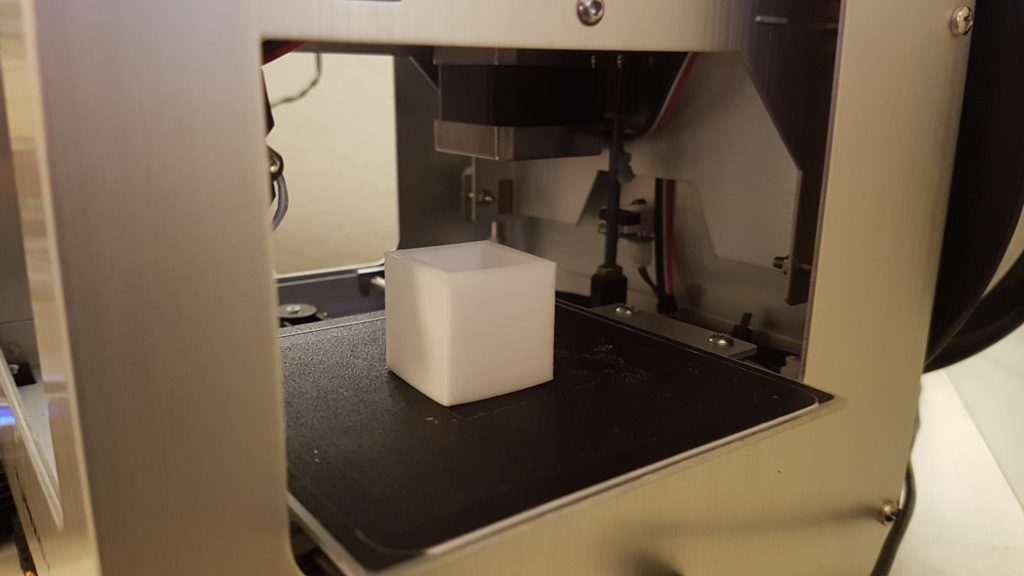My robot is in desperate needs of new parts, so I ordered the Fabrikator Mini v2 from Hobbyking (below 200 EUR with shipping). It has a 10x10x10cm build volume and a sturdy metal frame while it’s only 17cm wide, 18.5cm deep (28cm with the spool holder mounted in the back), and 18cm high, which means it fits in one compartment of an IKEA KALLAX shelf. The first impression is very positive!
In this post I will describe my first experiences, the setup in windows/linux, and which settings work best for me using RepetierHost and Slic3r.
I got it out of the box, hooked it up to power and USB, installed RepetierHost (Windows 10, the linux adventure is below), and it connected right away to the printer. After that I followed the manual (setting the correct printer-dimensions and suggested print parameters) and tried to print a calibration cube using slic3r. I say tried, because even after 5 printer-bed-levelings, the filament just would not stick to the bed. I increased the temperature, lowered the speed, nothing would help. In the end I realized that for some reason the print-head has some space to the bed even in the first layer, so I set the Z-offset to -0.25mm in the printer-settings of slic3r – that did the trick!
For anyone interested, here are my slic3r-settings at the moment. They are not optimal yet (I still have some stringing, and if you want really proper prints you need to go down with the speed even furter), but seem to work well on a range of objects:
For the interested, here is the progression that above parameters (middle) yielded from the stock ones (left), as I tried to print a different holder for the polulu ball-caster:
The linux adventure
I followed the regular procedure:
- Added my user to the dialout group:
sudo adduser USER dialout - Checked dmesg outputs, all fine, cdc_acm is loaded, /dev/ttyACM0 gets created
- Set the baudrate according to the manual in RepetierHost (115200)
- Connect to the printer
So far so good. Nothing would happen, the commands would just queue up, but every 10-20 seconds, one command would go through and the printer moved shortly. Even stranger, the homing-button of RepetierHost did work consistently!
After stumbling around the web and bug-reports in differnt git-hub repositories, I got to know that mono (the underlying framework for RepetierHost in Linux) still has Problems with non-ANSI baudrates. The baudrate stated in the manual (115200) does not seem to be correct, the printer currently works with 250000 baud, BUT: one has to set them outside of RepetierHost (because of the mono problems). The following procedure allows to use the printer with Reptierhost in Linux:
- Connect the printer
- Start ReptierHost, press „Connect“ (NOTHING ELSE)
- Use the following python script to set the baudrate:
#!/usr/bin/env python
import serial
serial.Serial("/dev/ttyACM0", 250000)
Designing and printing a part
For most stuff, I use OpenSCAD, an awesome piece of software that allows to create very complex objects from just scripted geometric primitives and boolean operations on them. Here is an example USB/SD/MicroSD-organizer I designed and printed on the Fabrikator:
There is still some warping (this organizer is 8x8cm) I need to work out, but as this has been printed without heated bed it might be an easy fix.















Comments (11)